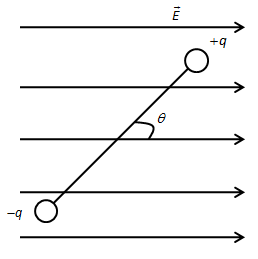
An electric dipole of dipole moment
A.
B. Zero
C.
D.
Answer
428.9k+ views
1 likes
Hint: Refer to the formula for the potential energy of the electric dipole. The negative sign of the potential energy of the dipole implies the minimum potential energy.
Formula used:
Here,
Complete step by step answer:
An electric dipole is a system of two opposite charges

The potential energy of the dipole is given by the equation,
Here,
The potential energy of the dipole is minimum, that is
Thus,
The potential energy of the dipole is zero, when the angle between dipole moment
Also, the potential energy of the dipole moment is maximum, that is
So, the correct answer is “Option C”.
Note:
The minimum potential energy of the dipole does not mean the potential energy to be zero. The potential energy of the dipole is minimum when the dipole is parallel to the external electric field. Also, it is the maximum when the dipole is anti-parallel to the external electric field.
Formula used:
Here,
Complete step by step answer:
An electric dipole is a system of two opposite charges

The potential energy of the dipole is given by the equation,
Here,
The potential energy of the dipole is minimum, that is
Thus,
The potential energy of the dipole is zero, when the angle between dipole moment
Also, the potential energy of the dipole moment is maximum, that is
So, the correct answer is “Option C”.
Note:
The minimum potential energy of the dipole does not mean the potential energy to be zero. The potential energy of the dipole is minimum when the dipole is parallel to the external electric field. Also, it is the maximum when the dipole is anti-parallel to the external electric field.
Latest Vedantu courses for you
Grade 11 Science PCM | CBSE | SCHOOL | English
CBSE (2025-26)
School Full course for CBSE students
₹41,848 per year
Recently Updated Pages
Master Class 12 Business Studies: Engaging Questions & Answers for Success

Master Class 12 English: Engaging Questions & Answers for Success

Master Class 12 Social Science: Engaging Questions & Answers for Success

Master Class 12 Chemistry: Engaging Questions & Answers for Success

Class 12 Question and Answer - Your Ultimate Solutions Guide

Master Class 12 Economics: Engaging Questions & Answers for Success

Trending doubts
Give 10 examples of unisexual and bisexual flowers

Draw a labelled sketch of the human eye class 12 physics CBSE

Differentiate between homogeneous and heterogeneous class 12 chemistry CBSE

Differentiate between insitu conservation and exsitu class 12 biology CBSE

What are the major means of transport Explain each class 12 social science CBSE

Draw a diagram of a flower and name the parts class 12 biology ICSE




